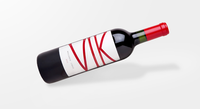Norwegian entrepreneur Alexander Vik embarked in 2004 on an effort to make a truly great wine in South America, searching for a superb site and searching with the best viticultural team he could hire. He settled on a  location two years later, buying … an entire valley. I have never met the man, but I did see the place last year, and I can say with certainty that he doesn’t mess around. Along with his wife, Carrie, Vik has built an eye-popping enterprise on more than 10,000 acres roughly 2 hours south of Santiago in Chile. The spectacular vineyard, winery, lodging and restaurant are set in the Millahue Valley, or “Place of Gold”, as named by the indigenous people.
location two years later, buying … an entire valley. I have never met the man, but I did see the place last year, and I can say with certainty that he doesn’t mess around. Along with his wife, Carrie, Vik has built an eye-popping enterprise on more than 10,000 acres roughly 2 hours south of Santiago in Chile. The spectacular vineyard, winery, lodging and restaurant are set in the Millahue Valley, or “Place of Gold”, as named by the indigenous people.
Now that we’ve worked the word “gold” into this account, I’m obliged as a journalist to acknowledge that almost anybody can produce something striking if they’ve got sufficient funds. However, not just anybody can create a genuinely distinctive and beautiful (as opposed to ostentatious)  winery and hotel. Moreover, not just anybody can set up a vineyard that makes downright great wine from the very start, and the French would tell you that it is impossible to make a great wine with vines planted for less than multiple decades. Well, one Frenchman in particular, Bordeaux-born Patrick Valette, has proved this wrong, and the 2011 release he has wrought along with winemaking partner Christian Vallejo proves the point absolutely convincingly. I’ll be writing more on Viña Vik in the coming year, as there’s much to be learned by examining just how this winery and vineyard got so good so fast. But for now, let’s just focus on the flagship wine:
winery and hotel. Moreover, not just anybody can set up a vineyard that makes downright great wine from the very start, and the French would tell you that it is impossible to make a great wine with vines planted for less than multiple decades. Well, one Frenchman in particular, Bordeaux-born Patrick Valette, has proved this wrong, and the 2011 release he has wrought along with winemaking partner Christian Vallejo proves the point absolutely convincingly. I’ll be writing more on Viña Vik in the coming year, as there’s much to be learned by examining just how this winery and vineyard got so good so fast. But for now, let’s just focus on the flagship wine:
Viña Vik, Millahue, Cachapoal Valley, Chile 2011 ($150): This is just the third release of this wine, made from extremely young fruit, but it already shows a mind-boggling level of complexity and class. Blended from Cabernet Sauvignon (55%), Carménère (29%), Cabernet Franc (7%),  Merlot (7%) and Syrah (4%), it shows beautiful and deep color extending all the way to the edge of a slanted glass. Balanced scents of fruit and subtly toasty oak are very alluring, with savory accents beginning to emerge in the aromas and flavors. Acidity, tannin and wood are all quite notable, but they present themselves very proportionally, and these structural elements leave center stage to the gorgeous fruit. This will unwind additional complexities for years to come, but is already a totally convincing wine. Tasted multiple times (including in a blind tasting alongside a sizeable set of Chile’s most eminent wines), I’ve consistently rated this at: 96
Merlot (7%) and Syrah (4%), it shows beautiful and deep color extending all the way to the edge of a slanted glass. Balanced scents of fruit and subtly toasty oak are very alluring, with savory accents beginning to emerge in the aromas and flavors. Acidity, tannin and wood are all quite notable, but they present themselves very proportionally, and these structural elements leave center stage to the gorgeous fruit. This will unwind additional complexities for years to come, but is already a totally convincing wine. Tasted multiple times (including in a blind tasting alongside a sizeable set of Chile’s most eminent wines), I’ve consistently rated this at: 96
1
